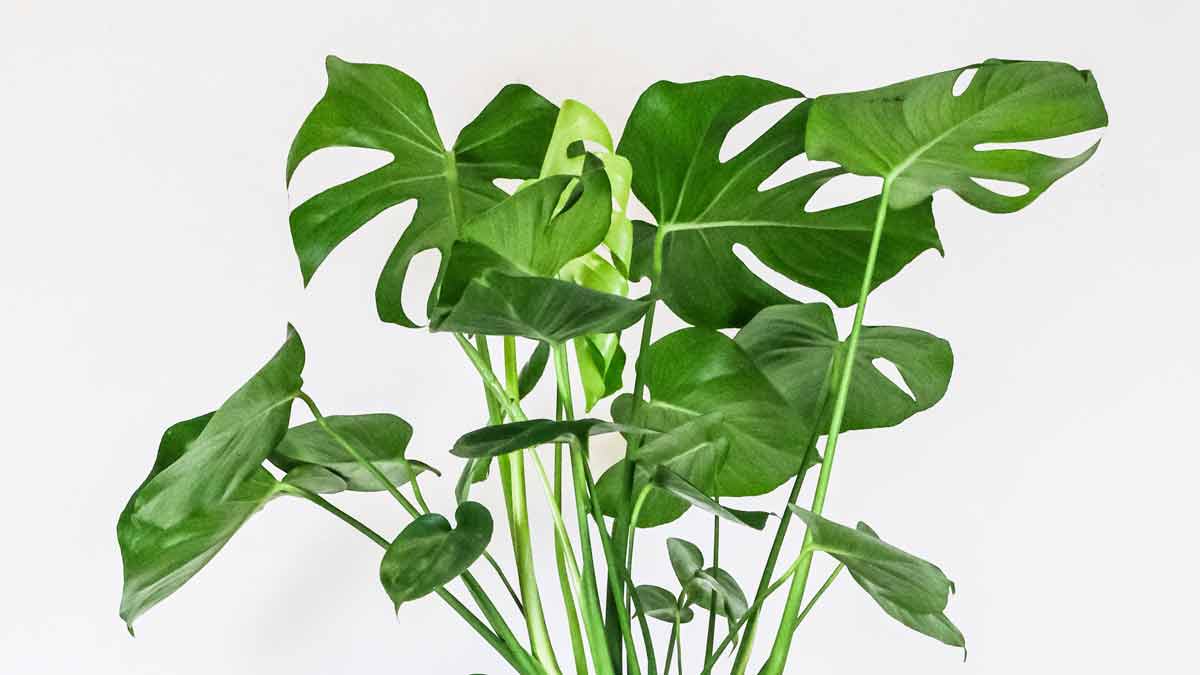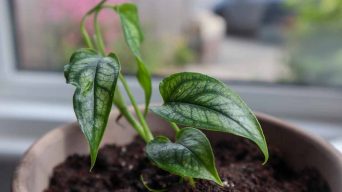Monstera plants are beautiful tropical houseplants that can spruce up any indoor space.
They are also relatively easy to care for, which makes them an excellent choice for plant newbies or busy people with little time to dedicate to plant care.
Despite their ease of care, monsteras can still experience some health problems from time to time. But if you know what to look for, it’s easy to tell if your monstera is healthy.
This article will teach you how to know if a monstera is healthy or not.
Signs of a Healthy Monstera
There are a few key things to consider when determining your monster’s health.
The most important things to look for are:
Leaves That Are Green and Glossy
Green and glossy leaves can be a sign of a healthy monstera plant. This is because these types of leaves are typically rich in nutrients, which help to support the plant’s overall health.
Additionally, glossy leaves tend to have a waxy coating on their surface, which helps to keep them moist and prevent moisture loss from evaporation.
To further protect themselves from bright sunlight, these types of leaves may also contain pigments called anthocyanins, which serve as a natural sunscreen and prevent damage from UV rays.
Overall, having healthy and glossy leaves indicates that your monstera plant is thriving and in good condition.
A Strong, Upright Stem
A strong, upright stem is often a sign that a monstera plant is healthy and thriving. This is due to several factors, including the plant’s natural growth patterns and response to various environmental conditions.
For example, monsteras typically do best in bright, humid environments with plenty of moisture and good airflow.
Because they are tropical plants, they also require consistent fertilization and regular watering to grow strong and resilient.
When all of these factors are considered, it becomes clear that a strong, upright stem is an important indicator of overall plant health.
So if you notice that your monstera is growing with confidence, you may rest assured knowing that you have done everything possible to support its well-being.
Healthy Roots
Monstera plants typically have healthy, white roots that are dense and fleshy. These roots are essential for several reasons, including anchoring the plant in the soil and absorbing water and nutrients from the surrounding environment.
Healthy roots help support the plant’s overall growth and development by providing a foundation for new leaves and stems.
If you notice that your monstera’s roots seem healthy and robust, it is likely an indicator that the plant is overall healthy and doing well.
A common sign of healthy roots is when they are white or cream in color and have a fleshy texture. If you notice that your monstera’s roots are healthy and robust, you can be confident that the plant is getting the resources it needs to thrive.
An Abundance of New Growth
When growing a monstera plant, you may notice that it is going through periods of rapid new growth. This can be a sign that your plant is healthy and thriving, as it has the nutrients and resources to support vigorous new growth.
This growth occurs at the ends of long, fleshy leaves called leaflets, which emerge from the plant’s central stem known as a rachis.
The foliage can grow quite large and become full, creating a lush green canopy that is both beautiful and functional.
An abundance of new growth on your Monstera plant shows that you are taking good care of it, giving you one more reason to be proud of this beautiful tropical perennial.
Signs of an Unhealthy Monstera Plant
While many signs can indicate that your Monstera plant is healthy and thriving, there are also a few key indicators that something might be wrong.
If you notice any of the following signs, it may be time to take a closer look at your plant to see if there are any areas of concern:
Yellowing or Browning Leaves
Monsteras are beautiful and highly sought-after houseplants, prized for their striking foliage and easy care requirements.
However, when you notice your monstera leaves becoming yellow or brown, you may be concerned that you are not properly caring for your plant.
In most cases, browning or yellowing leaves can be a sign that you need to change certain aspects of your care routine.
Factors such as incorrect watering levels, excessive exposure to sunlight, and improper nutrient intake can all cause your monstera leaves to turn yellow or brown.
To keep your plant healthy and vibrant, you should monitor its soil moisture levels, provide plenty of indirect sun exposure, and always use a high-quality fertilizer when repotting or reusing potting soil.
Dropping Leaves
When you notice your monstera plant dropping leaves, it can be a disturbing sign of an unhealthy or stressed plant.
While some leaf drop might be normal as the plant adjusts to new conditions, large amounts of shedding could cause concern.
Several possible reasons your monstera may lose leaves include too much direct sunlight, underwatering, overwatering, severe temperature fluctuations, and root rot.
To help keep your plant healthy and prevent further leaf loss, you should examine its care needs carefully and make any necessary adjustments as soon as possible.
With a little extra attention and care, you can help to maintain a thriving monstera plant that stays strong and graceful throughout the year.
Leaves That Are Wilting or Drooping
A Monstera plant is a beautiful, tropical plant that is beloved for its large, heart-shaped leaves.
However, you may notice that your Monstera tends to droop or wilt, particularly in times of stress or low light levels. This loss of leaf vitality can be a sign that your Monstera is unhealthy and in need of care.
There are a few possible causes behind wilting or drooping leaves on a Monstera plant. One common issue is insufficient watering.
When you water your Monstera plant, you want to ensure you thoroughly saturate the soil while avoiding overwatering and causing root rot.
You should also keep an eye on the humidity levels of your home or office: you may need to place your Monstera near a humidifier or mist it with water on hot days to prevent wilting from dry air.
Finally, ensure you provide your Monstera with enough bright indirect light: too much or too little sun can cause the leaves to wilt.
With a bit of attention to its care needs, you can help your Monstera maintain healthy, perky leaves all year round.
Stunted Growth
When you notice that your monstera plant is not reaching its full growth potential, it may indicate an underlying problem.
Several common factors can lead to stunted growth in these popular houseplants.
You may not be providing enough light to your monstera. Sunlight is essential to the plant’s ability to create and process nutrients. Due to this, it develops weak and spindly branches, causing overall growth problems.
Another possible cause of stunted growth is not providing proper care for your monstera. This might include overwatering or underwatering, reducing the availability of critical nutrients and damaging the plant’s roots.
A lack of humidity can also lead to issues with root health, weakened branches, and smaller leaf size.
If you want your monstera plant to reach its fullest growth potential, you must pay close attention to its environmental needs and provide appropriate care at all times.
Black or Brown Spots on the Leaves
Black or brown spots on the leaves of your monstera plant can be a sign of several possible problems.
One common issue is a lack of humidity, which can cause the plant’s leaves to dry and develop brown spots.
Too much direct sunlight can also lead to leaf scorching, which manifests as black or brown patches on the leaves.
Other possible causes of leaf discoloration include nutrient deficiencies, pests, and diseases.
Fungal diseases are particularly common in monstera plants. They can cause various symptoms, including brown or black spots on the leaves.
To prevent leaf discoloration, ensure your monstera plant gets enough humidity and indirect sunlight. You should also pay close attention to its nutrient needs and be on the lookout for signs of pests or diseases.
Leggy Growth
Leggy growth is a common issue in monstera plants, particularly when they are not getting enough light.
When a plant doesn’t get enough sunlight, it grows taller and thinner to reach the light source. As a result, the plant develops long, spindly branches and leaves that are far apart from each other.
Issues with water or nutrients can also cause leggy growth. For example, excessive watering of your monstera plant can result in root rot, which in turn causes the plant to grow weak and with elongated, spindly stems.
A lack of nutrients can also cause stunted growth and leggy branches.
To prevent leggy growth, you should ensure your monstera plant gets enough light, water, and nutrients. You may also need to prune the Monstera plant regularly to encourage full, healthy growth.
How To Keep Your Monstera Healthy
Monstera plants are relatively easy to care for, but there are a few things you need to do to keep them healthy.
Here are some tips to help you keep your monstera plant healthy:
- Make sure the plant has enough light. Monsteras need bright, indirect sunlight to thrive. If your plant is not getting enough light, it will lose its leaves.
- Water the plant regularly. Monsteras like to be kept moist but not wet. Water the plant when the top inch of soil is dry.
- Fertilize the plant monthly. Use a general-purpose fertilizer and follow the directions on the package.
- Prune the plant regularly. Monsteras can become overgrown quickly. Prune the plant to keep it healthy and under control.
- Monitor the plant for pests. Monsteras are susceptible to mealybugs and spider mites. If you see any pests on your plant, treat them immediately.
- Repot the plant every two to three years. Monsteras need room to grow, so they must be repotted every few years. When repotting, use a pot slightly larger than the current one.
Following these tips can keep your monstera healthy and looking its best.
Final Thoughts
As you can see, there are a few key indicators that your Monstera is healthy.
The plant should have bright, green leaves with no brown spots or tears. The stems should be strong and upright, and the roots should be white and healthy-looking.
If your Monstera meets all of these criteria, congrats! You have a healthy plant!







